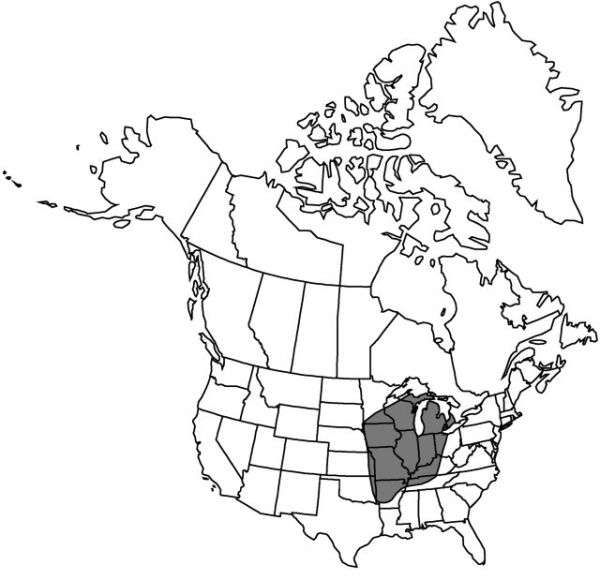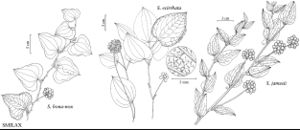Difference between revisions of "Smilax ecirrata"
in A. Gray et al., Manual ed. 6, 520. 1890.
FNA>Volume Importer |
FNA>Volume Importer |
||
| Line 11: | Line 11: | ||
|name=Coprosmanthus ecirrhatus | |name=Coprosmanthus ecirrhatus | ||
|authority=(S. Watson) Chapman | |authority=(S. Watson) Chapman | ||
| + | |rank=species | ||
}} {{Treatment/ID/Synonym | }} {{Treatment/ID/Synonym | ||
|name=Coprosmanthus herbaceus var. ecirratus | |name=Coprosmanthus herbaceus var. ecirratus | ||
|authority=Engelmann ex Kunth | |authority=Engelmann ex Kunth | ||
| + | |rank=variety | ||
}} {{Treatment/ID/Synonym | }} {{Treatment/ID/Synonym | ||
|name=Nemexia ecirrata | |name=Nemexia ecirrata | ||
|authority=(Engelmann ex Kunth) Small (as ecirrhata) | |authority=(Engelmann ex Kunth) Small (as ecirrhata) | ||
| + | |rank=species | ||
}} {{Treatment/ID/Synonym | }} {{Treatment/ID/Synonym | ||
|name=Smilax herbacea var. ecirrata | |name=Smilax herbacea var. ecirrata | ||
|authority=(Engelmann ex Kunth) A. de Candolle | |authority=(Engelmann ex Kunth) A. de Candolle | ||
| + | |rank=variety | ||
}} | }} | ||
|hierarchy=Smilacaceae;Smilax;Smilax ecirrata | |hierarchy=Smilacaceae;Smilax;Smilax ecirrata | ||
| Line 44: | Line 48: | ||
-->{{#Taxon: | -->{{#Taxon: | ||
name=Smilax ecirrata | name=Smilax ecirrata | ||
| − | |||
|authority=(Engelmann ex Kunth) S. Watson in A. Gray et al. | |authority=(Engelmann ex Kunth) S. Watson in A. Gray et al. | ||
|rank=species | |rank=species | ||
| Line 59: | Line 62: | ||
|publication year=1890 | |publication year=1890 | ||
|special status= | |special status= | ||
| − | |source xml=https://jpend@bitbucket.org/aafc-mbb/fna-data-curation.git/src/ | + | |source xml=https://jpend@bitbucket.org/aafc-mbb/fna-data-curation.git/src/f50eec43f223ca0e34566be0b046453a0960e173/coarse_grained_fna_xml/V26/V26_984.xml |
|genus=Smilax | |genus=Smilax | ||
|species=Smilax ecirrata | |species=Smilax ecirrata | ||
Revision as of 20:54, 16 December 2019
Herbs. Stems annual, erect to leaning, with bladeless bracts proximally, leaves distally, 0.3–0.8 m, herbaceous; prickles absent. Leaves mostly distal (upper 1/2–2/3 of plant); petiole thin, shorter than blade; tendrils few and short or absent; blade thin, broadly elliptic-ovate to subrotund, 9–12 × 5–9 cm, pubescent and not glaucous abaxially, base cordate to truncate, margins entire, convex, apex round to acuminate. Umbels 1–3, proximalmost axillary to bracts below leaves, to 25-flowered, hemispherical to globose. Flowers: perianth green; tepals 3.5–4 mm; anthers ± equaling filaments; ovules (1–)2 per locule; pedicel 0.5–1.3 cm. Berries purplish black, globose, 9–11 mm, not glaucous. 2n = 52.
Phenology: Flowering May–Jun.
Habitat: Open woods and thickets
Elevation: 100–800 m
Distribution

Ont., Ark., Ill., Ind., Iowa, Kans., Ky., Mich., Minn., Mo., Nebr., Ohio, Okla., S.Dak., Tenn., Wis.
Discussion
Smilax ecirrhata is similar to S. huberi and S. biltmoreana, both with fewer leaves of different shapes.
Selected References
None.
